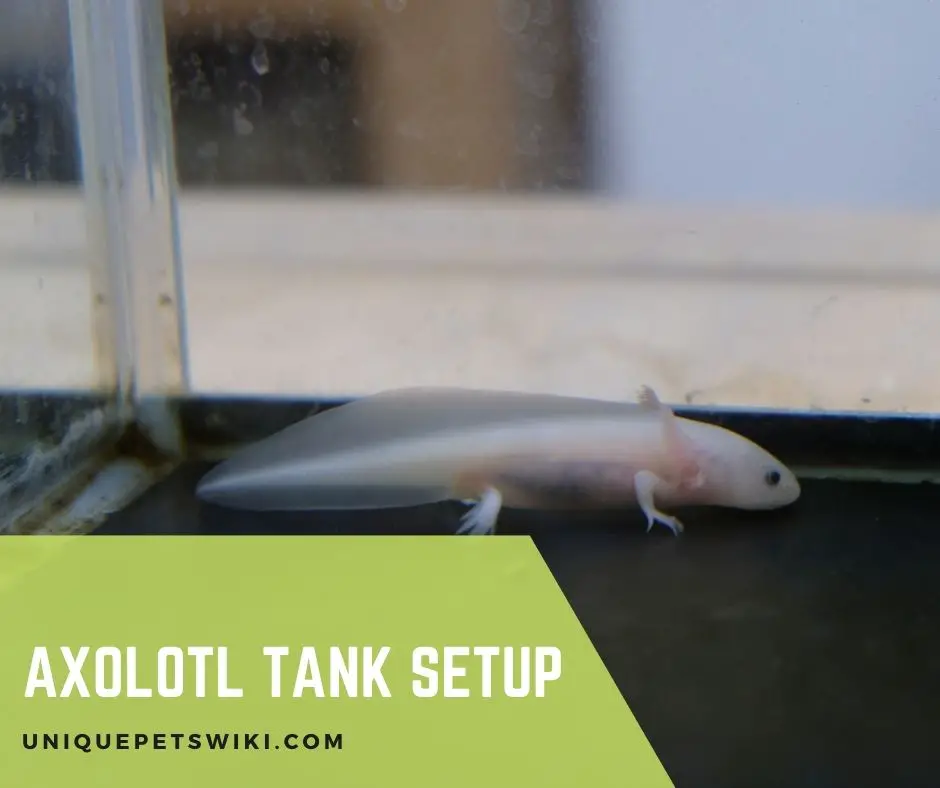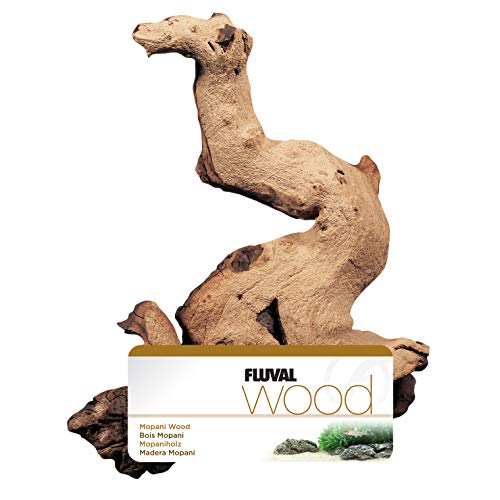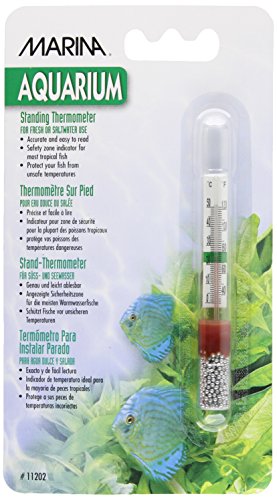Although axolotls are not common pets, they are unique animals to keep as a pet. Axolotls are considered an amphibian, and many call them walking fish. They belong to salamander species but do not undergo metamorphosis from larval to adult stage.
Keeping axolotl as a pet is a great option if you are looking for a unique aquarium project. It is important to choose the right tank for your axolotl for them to stay healthy and happy. However, they are hardy creatures and can stay in different water conditions.
In this article, we will describe in detail everything you need to know about axolotl tank setup, from the recommended tank size to the suitable water parameters they need to survive.
Contents
Habitat Of Axolotl In The Wild
Axolotls originate from several lakes like Lakes Xochimilco and Chalco in Mexico. These lakes are usually fed by runoff from mountain streams which helps to keep the water cool and clear. This is because Axolotls are very sensitive to nitrates, ammonia, and nitrites.
Axolotls have a small native range in the wild. Currently, that small native range is shrinking because of human urbanization.
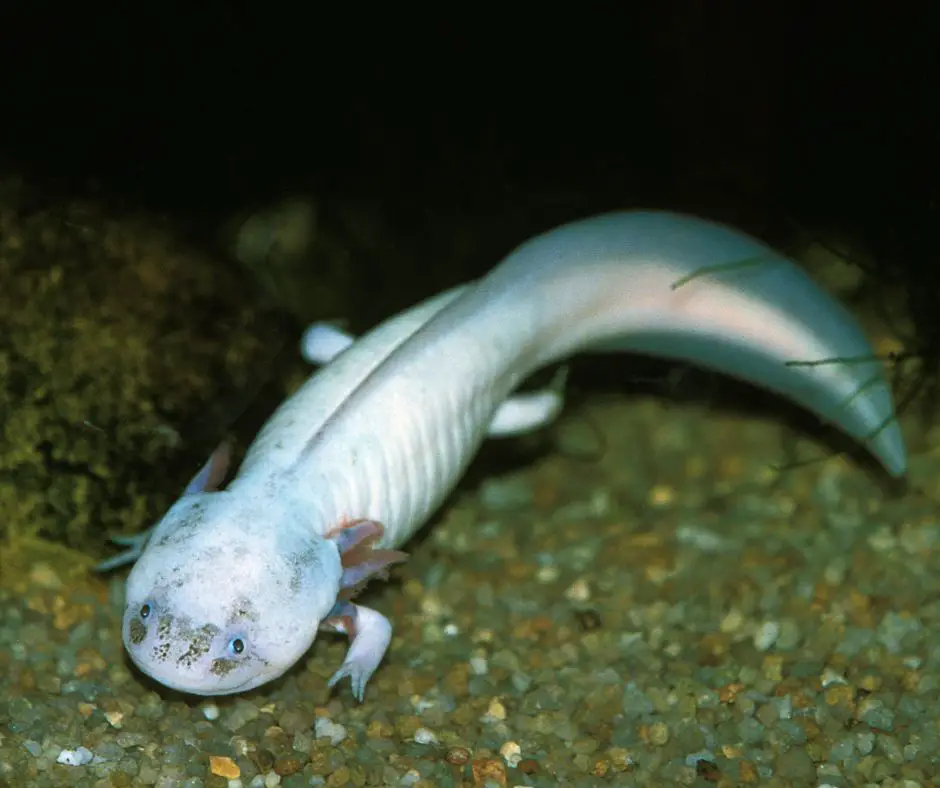
Axolotl Tank Setup: Step By Step Guide
Caring for axolotl is not for beginners as it requires knowledge of aquarium maintenance and water parameters. Everything that you need to know about the Axolotl tank setup is stated below.
Enclosure For Axolotl
One of the important things you need when keeping an aquatic creature is the right tank. Although many keepers use a 10-gallon aquarium for housing their axolotl, this cannot sustain them in the long run.
Axolotls can grow to about 10 inches in size, and it is best to keep them in a larger tank. Furthermore, axolotls produce a lot of waste, and using a small aquarium requires lots of maintenance to keep the water clean for them.
It is best to keep a single axolotl in a 20-30 gallon tank as you will be able to control the ammonia and nitrate levels easily. Your axolotls will also have enough space to explore and play. You will need an additional ten extra gallons if you plan to keep more than one axolotl in the tank.
SeaClear 30 gal Show Acrylic Aquarium Combo Set, 36 by 12 by 16″, Clear
- Combo includes aquarium, reflector and electrical 24" light fixture
- Acrylic aquariums are clearer than glass, 17 times stronger, and only half the weight!
- More impact resistant and less prone to chipping or cracking than glass, making it safer around children and pets
- Safe for Salt or Freshwater
- You won't believe how your fish and decorations will pop when viewing this beautiful SeaClear aquarium
Last update on 2022-12-29 / Affiliate links / Images from Amazon Product Advertising API
Tank Shape For An Axolotl
Apart from the size, you need to choose a rectangular aquarium to ensure your axolotl has enough space to swim around freely. You should avoid any orb-shaped tanks because your axolotl will not have enough space.
Another thing is that axolotls are bottom dwellers and will need open floor space. This means a bow front, rectangular-shaped, and corner tanks are suitable for them as they will have enough floor space to explore.
Axolotl Tank Lid
Although axolotls are bottom dwellers, they do swim to the surface from time to time to gulp air. They also jump up, and it is best to have a lid on their tank. This will help to ensure your axolotl does not fall out and injure itself.
There should be around 2 inches distance between the tank lid and water level when using a tank lid. The tank lid should also have holes to help ensure there is good airflow. If not, there will be bacteria and algae growth in their cage.
Substrate For Axolotl
Many axolotl keepers usually keep their axolotl in a bare bottom tank. This usually makes it easy to clean the tank, but it may not be healthy for your pet. This can make your axolotl stressed as they will not want to slip on the tank bottom. They can then develop sores on the toes because they try to hold on.
Axolotl also needs things to keep them occupied to avoid boredom. Without a substrate, your axolotl will not display natural foraging behavior like digging.
However, axolotls are curious creatures, and they can ingest the substrates. If your axolotls ingest small stones or gravel, it can cause intestinal blockage and be lethal to them. Sharp stones or glass chippings can also injure your axolotls, and you should avoid them as well.
It is recommended to use a bare bottom tank for baby axolotls under 5 inches to help ensure they don’t ingest substrates and for easy tank maintenance. You can then opt for slate tile, natural sand, or large rocks for older axolotls.
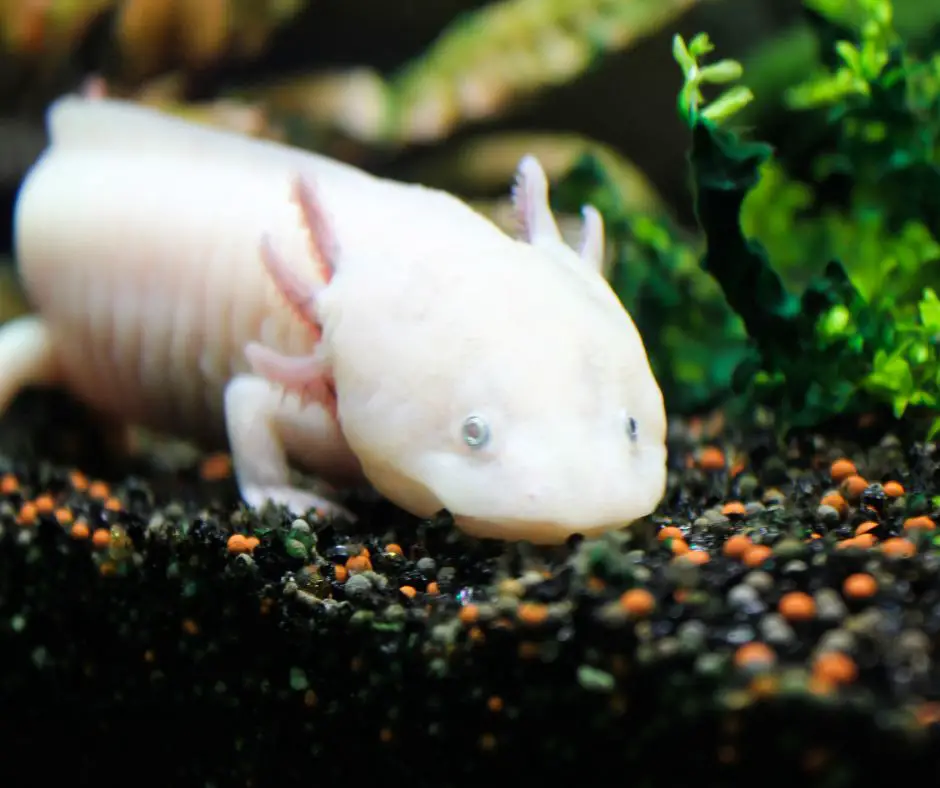
Some of the best substrates for axolotls are:
- Natural fine sand or play sand (no coral, sparkling crushed rock, quartz)
- Slate pieces
- Ceramic or slate tile
- Smooth gravel (at least 3-4 times the diameter of your axolotl’s head).
African CICHILD Aragonite 10LB Sand for Aquarium
- Unsurpassed buffering capability
- 98% pure calcium carbonate
- Naturally renewable oolitic aragonite
- Sustainably sourced
- Phosphate free
Last update on 2022-12-29 / Affiliate links / Images from Amazon Product Advertising API
Some substrates that are bad for your axolotl and you should avoid them are
- Crushed rock
- Glass chippings
- Small rocks or gravel
- Glass stones or marbles
- Sharp stones
- Broken shells
Heat And Lighting For Axolotl
Here is the heat and lighting requirement that you will need when setting up your axolotl’s tank.
Heat
Temperature is among the important criteria to keep your axolotls healthy for the long term. Axolotls are cool-water animals, and they easily get stressed in high-temperature water. In the wild, they are found in lakes at a higher altitude which is usually cooler than low-altitude climates found in the same area.
Keeping axolotls in a tank with a temperature above 75oF can be quite stressful for them. Furthermore, staying in this condition for an extended period of time can lead to illness and even death. It is best to house them in a tank below 70oF but not less than 50oF.
They can survive in a tank with a 70-74oF temperature, but this can be stressful for your axolotl and even the owners. The warmer the water in the tank, the less oxygen the water can hold.
The warmer is your axolotl aquarium, and you will have to provide more aeration and keep a tab of the oxygen level.
Lighting
Axolotls are nocturnal creatures, and providing bright lights with little hiding places can be stressful for them. They prefer to hide during the day and be active during the night. This means axolotls don’t need bright light at all, and using powerful lamps can easily stress your pet.
It is recommended that you find a lamp that is not bright but can allow you to see your pet without having to scare them into hiding all the time.
Decor Landscaping And ‘Furniture’ For Axolotl
It is also important for owners to provide decorations and plants in their axolotl tank. This will help create shade and spaces where your axolotl can hide when scared or things get too bright. Some of the décors suitable for your axolotl are stated below.
Plants
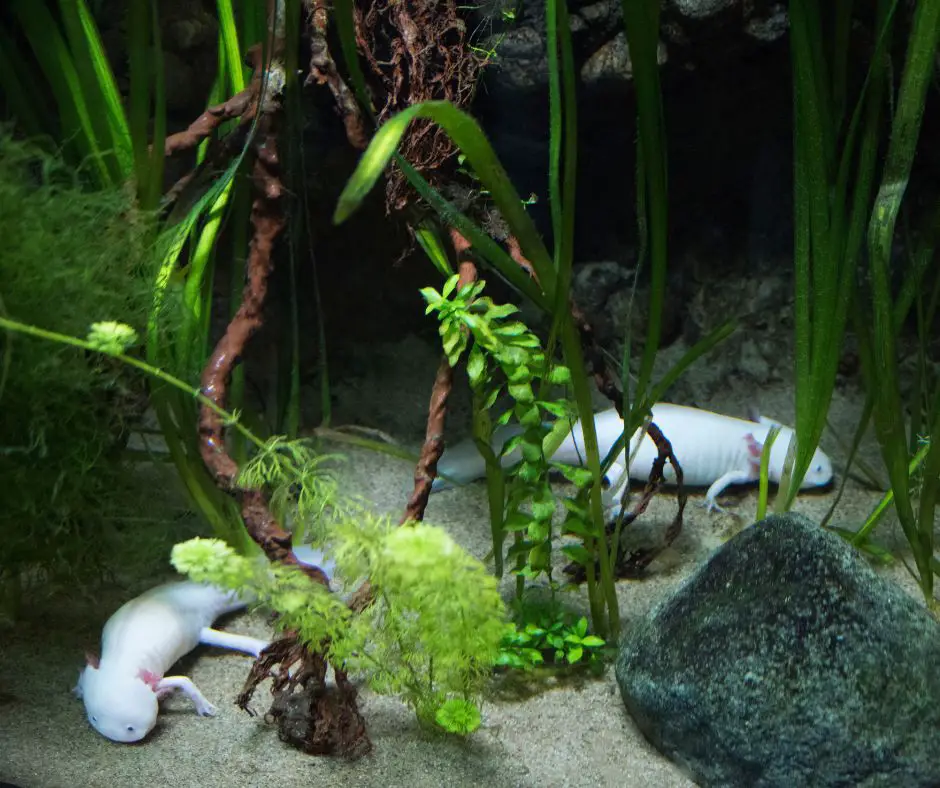
You can use either live or fake plants for your axolotl’s tank. It is easier to maintain fake plants, but live plants will help to oxygenate the tank water, aids the nitrogen cycle and growth of algae.
It is best to use silk plants or soft plastic plants that cannot injure your axolotl’s skin when using fake plants. If you opt for live plants, you need to ensure the plants that you use can thrive well under low light and temperature.
It is recommended that you use free-floating plants for your axolotl tank because they usually uproot plants. You can then anchor the plant in the substrate. If you are not using free-floating plants, you can place the plants in small pots.
Some of the best live plants are:
- Java moss
- Water cabbage
- Anubias
- Java fern
- Elodea
- Cabomba caroliniana
- Egeria densa
Driftwood
Axolotl’s owners can use driftwood to provide a natural look for Axolotl’s tank. Apart from this, it will also serve as a hiding place for your pet. You can use chunky driftwood that does not have sharp edges, and your pet cannot get stuck in it.
Some of the best driftwood you can use are Cholla wood and Mopani Wood.
Fluval Mopani Driftwood, Aquarium Decoration, Small, 11817A1
- All-natural driftwood providing a decorative accent to your aquarium
- Mopani driftwood ornamental root provides a safe haven for fish
- Adds natural beauty to aquariums and terrariums
- Sandblasted finish eliminates all extraneous material
- Approximate dimensions: 4 inches by 10 inches (due to this being a natural product, sizes are not exact)
Last update on 2022-12-29 / Affiliate links / Images from Amazon Product Advertising API
Rocks
Another décor idea for your axolotl’s cage is using rocks. This ranges from river rocks to dragon stones. However, you will need to ensure the rocks are free from calcium and metals that can leach into their tank.
AquaNatural 15lb Silver Seiryu Rock Mountain Stone for Aquariums
- Inert - will not affect water pH
- Rare and unique - exclusive to Aqua Natural
- Rugged black, silver and white streaks throughout rock
- Natural - no plastics, toxins or nasties
- Hand collected and packed
Last update on 2022-12-29 / Affiliate links / Images from Amazon Product Advertising API
Hides
Axolotls need a place where they can hide when they are feeling stressed. You will find lots of natural-looking hides out there to serve this purpose. Some of the hides you can use are ceramic pots, cichlid rocks, halved coconuts, Pleco breeding caves, or PVC pipes.
Exo Terra 0015561229319 1 Reptile Cave – Medium, Multicolor
- Natural appearance, can be integrated into any type of terrarium
- Offers a secure hiding place;
- Very stable, larger animals from getting easily tipped over
- Included Components: Terrarium Accessory
- Age Range Description: All Life Stages
Last update on 2022-12-29 / Affiliate links / Images from Amazon Product Advertising API
A Filter And A Thermometer In The Tank
It is important to have a thermometer in an axolotl cage to help ensure optimal temperature. The tank of an axolotl should be between 58-68oF to keep them healthy. The temperature in their tank should not go below 50oF or above 73oF as this can stress out your axolotl.
It will also affect their metabolism and can lead to death. This is why you will need a thermometer to make sure the temperatures are stable.
Apart from a thermometer, a vital accessory in Axolotl’s tank is a filter. This is because axolotls produce lots of waste that should be filtered away from the water. Using a filter helps to reduce the time that you change the water in the tank from daily to maybe weekly.
Marina Standing Thermometer, Fahrenheit and Celsius Aquarium Thermometer, 11202
- Fish tank thermometer designed to sink to the bottom
- Remains standing in a vertical position
- Accurate and easy-to-read thermometer
- Provides readings in Fahrenheit and Celsius
- Includes safety zone indicator appropriate for most tropical fish
Last update on 2022-12-29 / Affiliate links / Images from Amazon Product Advertising API
Water For Axolotl
Like all fish kept in an aquarium, Axolotl does best in a certain water value. Before you introduce axolotl to a tank, you will need to cycle the aquarium for a few weeks. This will help build up the beneficial bacteria needed to turn toxic ammonia in axolotl’s waste into less harmful waste.
You can kickstart the cycling process by adding household ammonia or some fish food to the tank.
Water Parameter For Axolotl
Here are some of the water quality parameters needed by axolotl to stay healthy and happy.
- pH: Axolotls are freshwater creatures and will need an alkaline water to stay healthy. The pH of the water should be between 7-7.5 and should not go higher than 7.6 or below 6.5.
- Alkalinity of water (KH): this is the ability of water to neutralize acid. Axolotls do well in water with KH levels between 53.7-143ppm (3-8o)
- Water hardness (GH): axolotls do best in hard water. This means they need water with 125-250ppm (7-14o) GH to stay healthy.
- Specific gravity (sg) or salinity level: axolotls are freshwater animals and the sg should be about 1.0000.
- Levels of ammonia, nitrites, and nitrates: they are toxic to axolotls if they are present in high quantities. This is why all the parameters should be 0 while the nitrate levels should be around 0-40ppm.
Water Test Kit
Another thing is that you will need to test the water occasionally, even after adding axolotl to the water. This can be done once in two weeks. You can use a water test kit for this process. There are liquid test kits that you can use to test for ammonia, nitrate, nitrite, and the pH of your axolotl’s water.
It is also good to check for specific gravity and water hardness of the water. One of the best test kits for monitoring the water quality in your axolotl’s tank is the API Freshwater Master Test Kit.
API FRESHWATER MASTER TEST KIT 800
Last update on 2022-12-30 / Affiliate links / Images from Amazon Product Advertising API
Note: ensure you run your filter all the time during the cycling process. The filters should have biological media that can help in nitrifying the tank.
Should You Keep Axolotl With Other Ones?
Axolotls are solitary creatures and do fine when alone. This means you don’t need to keep them with any tank mates. However, some owners have successfully kept them in pairs.
But you will need to be extra careful and watch them closely. This is because they can fight each other, leading to the loss of limbs. However, Axolotls can regenerate their limbs after an injury.
Axolotl can also display cannibalistic behavior towards each other. This is why it is best to keep them apart to avoid all these.
Conclusion
Axolotls are not demanding pets when it comes to regular husbandry and care. However, you will need to know water quality and aquarium cycling to make things easier. This is why they are not suitable for first-time owners.
We hope the information provided in this article helps give you an insight into how to take care of your axolotl. If you have any questions or comments about setting up an axolotl tank, you can contact us in the comment section below.
